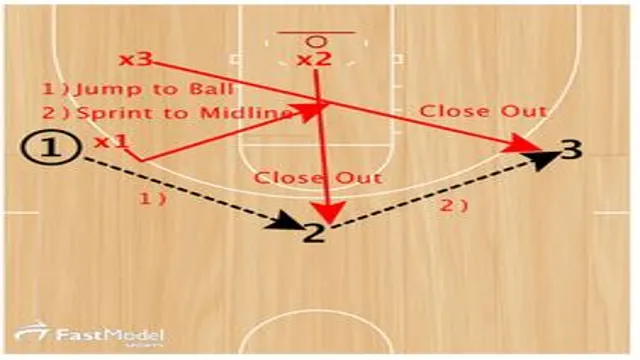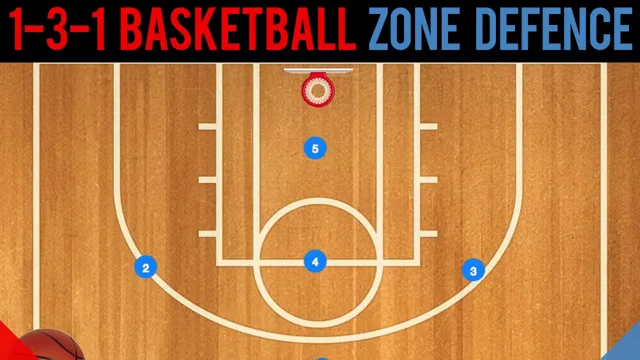Are you looking to improve your basketball team’s defense? One way to do so is through closeout drills. These drills help players develop their footwork, ability to read an offensive player’s movements, and close gaps quickly. Picture a defender sprinting towards a shooter, closing the distance between them, and jumping to contest the shot just as the ball leaves the shooter’s hand.
This is the result of practicing closeout drills and perfecting the technique. Closeout drills also help players learn how to anticipate their opponent’s next move and adjust their defense accordingly. By incorporating these drills into your team’s practice routine, you can help your players become more agile and effective defenders.
Whether you’re running a full-court drill or focusing on one-on-one situations, closeout drills can help your players take their defense to the next level. So why not give it a try, your team will be sure to thank you for it.
Importance of Closeout Drills
Basketball closeout drills are essential for any team that wants to succeed on the court. Closeouts are an integral part of basketball defense, and without proper execution, it can lead to easy scoring opportunities for the opposing team. Closeout drills help players understand the importance of quickly closing out on shooters and stopping them before they release the ball.
They also help them develop proper defensive footwork, speed, and agility. These drills require players to move around the court while maintaining focus, balance, and control. By practicing closeout drills regularly, players can improve their overall defensive skills and help their team win more games.
So, basketball coaches should ensure that closeout drills are an essential part of their practice sessions.
Decrease opponent’s shooting percentage
Closeout drills are an essential aspect of basketball training, especially when it comes to decreasing the opponent’s shooting percentage. In basketball, a closeout refers to the defensive move in which a player rushes towards an offensive player to play defense and prevent them from taking a shot. Closeouts are essential as they disrupt the opponent’s rhythm and force them into making mistakes.
Closeout drills build different skills necessary to defend against different types of shots from different locations on the court. Practicing these drills regularly can improve a player’s ability to react and move quickly, understand angles, and anticipate offensive moves. Ultimately, this helps to decrease the opponent’s shooting percentage and increase your team’s chances of winning.
So, if you want to excel on the defensive end, be sure to incorporate closeout drills into your training routine.

Increase team defensive efficiency
Closeout drills are an essential part of any basketball team’s defensive training regime. The ability to successfully close out on shooters can make all the difference in a game. Closeout drills allow players to improve their footwork, technique, and timing when closing out on an offensive player.
By mastering these skills, they can effectively defend their opponent and prevent them from scoring. Teams that consistently perform closeout drills can increase their overall defensive efficiency and limit their opponent’s offensive opportunities. So, if you’re looking to improve your team’s defensive performance, don’t forget to include closeout drills in your training routine.
Closeout Drill Types
Basketball closeout drills are essential for any team that wants to improve their game. There are several types of closeout drills that coaches can incorporate into their training sessions to help players become more efficient in defense. The first type is the “closeout and contest” drill, where players practice pivoting, closing out, and contesting a shot.
The second type is the “closeout and retreat” drill, where players practice closing out and then quickly retreating back to their assigned defensive position. The third type is the “closeout and slide” drill, where players practice a lateral slide motion after the closeout to prevent the offensive player from dribbling past them. These drills not only improve players’ defensive skills but also help them become more agile and quicker on the court.
By incorporating these drills into their training, teams can build a stronger defensive foundation and become a more well-rounded team.
Short Closeout Drill
Closeout drills are an essential part of basketball training for teams at all levels. Short closeout drills are particularly useful for improving a player’s ability to quickly close the gap between themselves and the opposing player with the ball. These drills aim to improve speed, agility, and reaction time, giving players the skills they need to quickly defend against an offense.
Short closeout drills can take many forms, including partner drills, cone drills, and full-court drills. In partner drills, players take turns dribbling the ball while their partner practices closing out. Cone drills involve setting up cones at different points on the court, with players practicing quickly closing out to each cone.
Full-court drills involve playing a full game while focusing on maintaining tight defensive play through short closeouts. By incorporating short closeout drills into their training routines, basketball players can significantly improve their defensive play and overall performance on the court.
Fake Recovery Drill
When it comes to closeout drills, one type that organizations should be aware of is the fake recovery drill. This particular drill involves simulating a situation where there is an ongoing emergency, such as a natural disaster or security threat. The goal is to test the organization’s ability to respond to the situation and recover from it.
However, unlike a regular disaster recovery drill, a fake recovery drill does not have a predetermined end time. Rather, it is meant to continue until the organization can successfully recover from the simulated emergency. This means that the drill can last several hours or even days, depending on the severity of the emergency and how long it takes for the organization to fully recover.
By conducting a fake recovery drill, organizations can get a better understanding of their preparedness for real emergencies and make any necessary improvements to their emergency response plans.
Closeout and Contest Drill
The basketball closeout drill is an essential component to any team’s pregame routine. This drill is intended to improve both defensive footwork and reaction time. The concept is simple: two teammates stand on opposite sides of the court while one closeout defender sprints from the baseline to the three-point line to defend against the offensive player.
There are many different types of closeout drills that coaches can implement during practice, including the two-line closeout, three-man closeout, and the shell closeout. Each variation puts players in different defensive situations that help to hone specific skills. By incorporating closeout drills into practice, players can learn how to defend more effectively while building agility and quickness.
Common Closeout Mistakes
Basketball closeout drills are an essential aspect of any basketball team’s defense. However, coaches and players often make common mistakes during closeout drills that can lead to a breakdown in their defensive strategy. One of the most common mistakes is not closing out fast enough, which gives the offensive player more space and time to shoot.
Another mistake is closing out too aggressively, which can leave the defender out of position and vulnerable to a fake or a drive to the basket. It’s important to practice closeout drills regularly to ensure that players develop the proper technique and timing. By incorporating basketball closeout drills into your team’s training and avoiding common mistakes, you can strengthen your defense and increase your chances of winning games.
Slow Footwork
When it comes to defending, closeouts are a critical part of the game. However, many players struggle with making the proper closeouts due to slow footwork. Players often underestimate the importance of quick feet when closing out, which leads to vulnerable gaps that opponents can exploit.
This mistake is common among both amateur and professional players, and it can be detrimental to the outcome of the game. Luckily, there are drills that players can use to enhance their footwork and, in turn, make better closeouts. By working on their agility and explosiveness, players can improve their reaction time and make closeouts with ease.
Practice makes perfect, and this skill is no exception. By dedicating time to footwork drills, players can develop the quick feet needed to defend effectively on the court.
Lack of Communication
When it comes to completing projects, communication is key. Lack of communication is one of the most common closeout mistakes that can cause delays and compromise the final outcome. It’s essential to make sure that all stakeholders are aware of the project’s progress and any changes that may impact the timeline or budget.
Additionally, communication ensures that everyone is on the same page in terms of expectations and responsibilities. Failing to prioritize communication can lead to misunderstandings, errors, and conflicts. To avoid this, holding regular check-ins, providing status updates, and maintaining an open-door policy to encourage questions and feedback can make a significant difference.
By prioritizing communication, everyone can finish the project successfully, on time, and with the desired outcomes.
Tips for Successful Closeouts
When it comes to basketball, closeout drills are essential to successful defense. The goal of a closeout is to quickly and effectively shut down the shooter without fouling them. Firstly, it’s important to always be aware of the shooter’s tendencies, as this can help you anticipate their next move.
Secondly, footwork is key to a successful closeout. Start with a small hop step in the direction of the shooter, then quickly shuffle your feet to get in front of them. Finally, it’s important to maintain a low stance throughout the closeout, as this allows for quick changes in direction and better balance.
By incorporating these tips into your closeout drills, you can improve your defensive skills and help your team come out on top.
Conclusion
In the game of basketball, every possession counts and closing out on defense is key. These closeout drills not only improve defensive skills but also teach players the importance of agility, communication, and anticipation. By mastering these drills, players can become unstoppable on both ends of the court and leave their opponents empty-handed.
So, remember to always closeout with ferocity and finesse because in basketball, defense truly is the best offense!”
FAQs
What are some basketball closeout drills for improving defense?
Some effective basketball closeout drills to improve defense include the one-step closeout drill, the two-step closeout drill, and the three-step closeout drill. These drills focus on closing out on the offensive player while maintaining proper defensive stance and body position.
How can I improve my footwork in basketball closeout drills?
You can improve your footwork in basketball closeout drills by focusing on proper technique and form. This includes maintaining a low center of gravity, using short and quick steps, and staying balanced and under control at all times.
What are some common mistakes to avoid in basketball closeout drills?
Some common mistakes to avoid in basketball closeout drills include failing to maintain proper defensive stance and position, being too slow or hesitant in closing out on the offensive player, and failing to maintain proper balance and control during movements.
How can I incorporate basketball closeout drills into my training routine?
You can incorporate basketball closeout drills into your training routine by starting with basic drills and gradually increasing difficulty and intensity. It can also be helpful to practice these drills in small groups or with a partner to simulate game-like situations and improve teamwork and communication skills.


